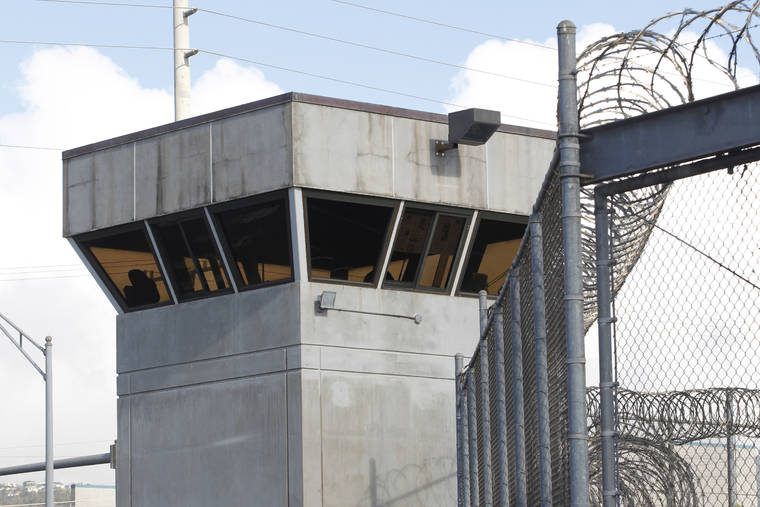About 40% of Oahu Community Correctional Center inmates tested for coronavirus are positive

STAR-ADVERTISER FILE
Four out of every 10 Oahu Community Correctional Center inmates tested for COVID-19 have received positive results since mass testing began at the Kalihi facility a week ago, according to numbers extrapolated from the daily totals issued by the state Department of Public Safety.
Of the 474 inmates tested since Aug. 11, 199 have received positive results. That’s about 42% of those tested.
Public Safety Director Nolan Espinda reported last week that OCCC had 968 inmates on Thursday, so the 199 positive results represent about 20.6% of the total population.
Public Safety officials said they intend to test the remaining OCCC inmates in the coming days.
On Tuesday, Public Safety reported 215 inmates (including 16 who tested positive before mass testing began) had tested positive, 34 more than the previous day. The 34 came from 116 tests, so about 29% of the batch tested.
Additionally, the department reported 34 total OCCC adult corrections officers or other staff have tested positive, up 4 from the previous day. Employees are not required to test, while some may be getting tested outside the jail’s grounds
Don't miss out on what's happening!
Stay in touch with breaking news, as it happens, conveniently in your email inbox. It's FREE!
The combined 249 inmates and staff that DPS reported with positive results was 38 less than the 287 total positive cases that state Health Director Bruce Anderson cited during a Tuesday afternoon press conference.
Asked to explain the discrepancy, Health Department spokeswoman Janice Okubo said Anderson receives his daily counts from state Epidemiologist Sarah Park. Park “receives her data directly from electronic laboratory reports so the information is likely more recent” than what DPS provided to media earlier in the day, she said.
Under orders issued by the Hawaii Supreme Court, about 30 inmates who are at OCCC due to petty misdemeanor or misdemeanor convictions are expected to be released by today. Most of the roughly 270 inmates who fall into those categories do not qualify based on the court’s criteria because they have tested positive or are awaiting test results, Deputy Public Defender Jacquie Esser said.
Under a separate order issued by the High Court, judges are expected to determine by Monday who among the several hundred OCCC felony category inmates qualify to be released.
The releases were triggered by a petition filed by the Office of Public Defender which urged the court to release as many OCCC inmates as quickly as possible to lower the potential for the spread of coronavirus at the facility that’s notorious for its overcrowding.
In April, in response to earlier motions filed by Public Defender James Tabe, the Hawaii Supreme Court ordered a process that allowed several hundred inmates to be released under an expedited process.
But amid a slowdown in the number of coronavirus cases in June, the process was halted by the court and the populations at OCCC and the other facilities again began to increase.
Lawyers for Equal Justice, comprised of lawyers who advocate for inmates, on Tuesday released a report that said prosecutors, politicians and the news media collectively inflamed public fears about the mandate and suggested it may have had a bearing on the court’s decision to halt its expedited release program.
Tom Helper, litigation director for the group, said the Supreme Court’s original release initiative a “courageous” one aimed at “trying to prevent the very problem that we’re facing now.”
Government officials resisted the initiative “and worked to undermine the process and stop it from happening,” Helper said. Some ridiculed the concerns raised about the potential for outbreak. Prosecutors also released a list of re- offenders without context or full information, suggesting it would lead to a significant crime increase he said.
However, Helper said, “most of the people who were released were not re- arrested; most of the people who were re-arrested were arrested for things like homelessness-related offenses (like) sleeping in the park, for technical offenses such as failing to call a probation officer.”
There were a few who committed serious crimes, but at a smaller percentage than during normal times and “in context, not even close to the crime wave or crime spike asserted by public officials.”
Will Caron, communications director for the Hawai‘i Appleseed Center for Law and Economic Justice, said local media outlets “did have an impact in creating this false narrative by amplifying some of the false statements like the prosecutor were making.”
That had an impact on public perception, “which in turn contributed to the premature termination of the program and now we’re in this situation,” Caron said.
Brooks Baehr, a spokesman for the prosecuting attorney’s office, declined to comment on the report and instead referred media to the brief the agency filed Monday with the Supreme Court opposing the current proposal for expedited inmate release.
The 16-page filing said Honolulu Acting Prosecuting Attorney Dwight Nadamoto’s concerns about the initial release “have proven to be well-founded, as demonstrated by the dozens of inmates who have been released pursuant to COVID- 19 only to be re-arrested shortly thereafter.”
The brief added: “While some of these re-arrests were because of technical violations and failures to abide by their conditions of release, others have committed new and serious crimes that might have been preventable with greater scrutiny of potential inmate releases.”



